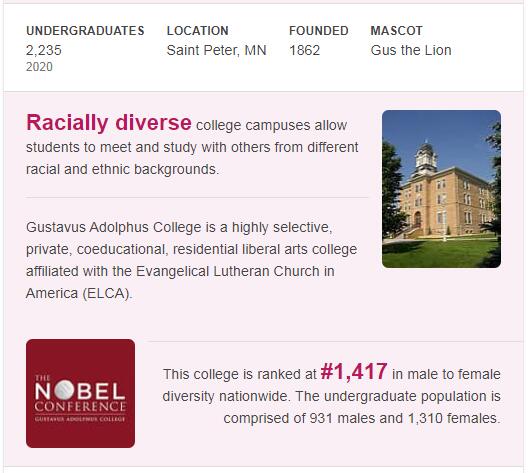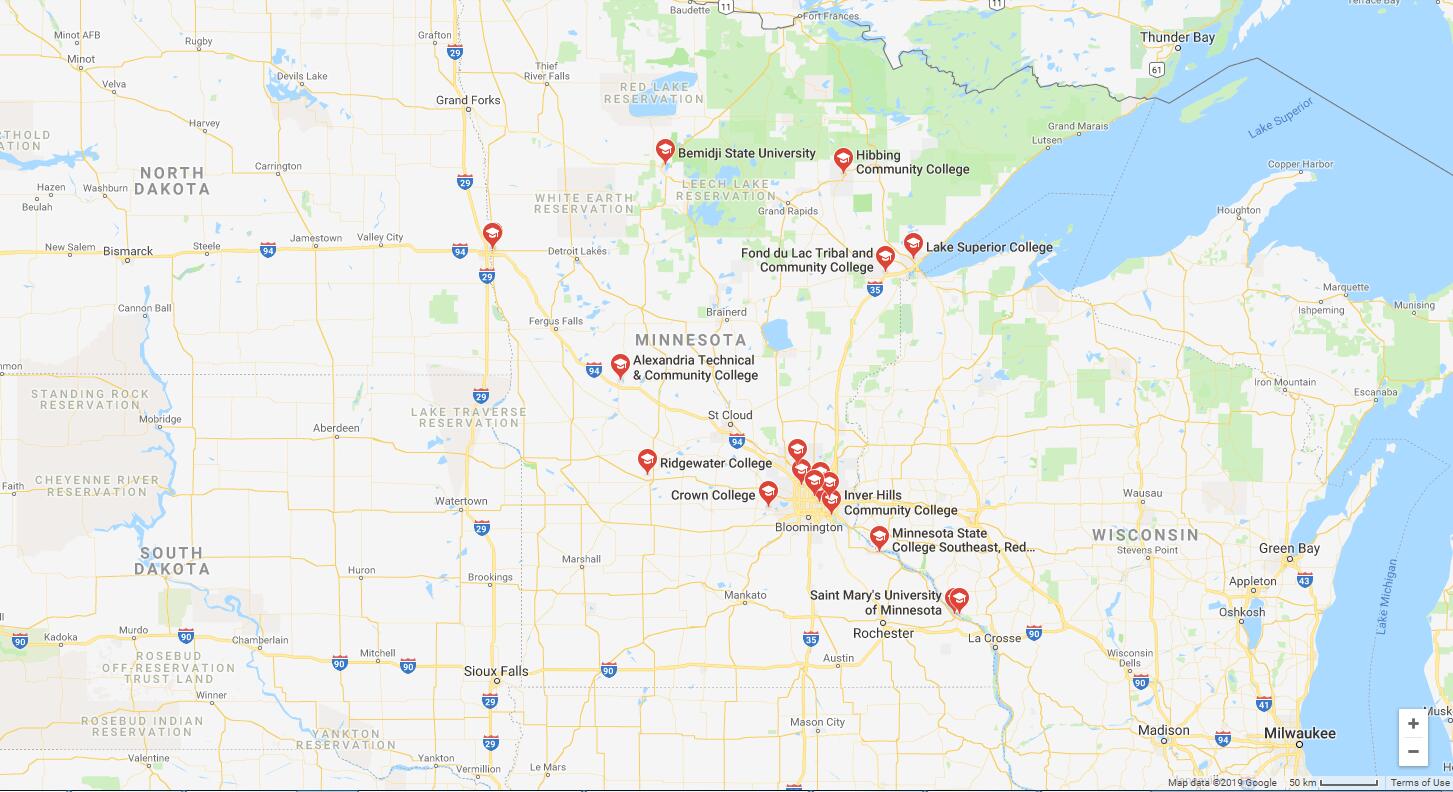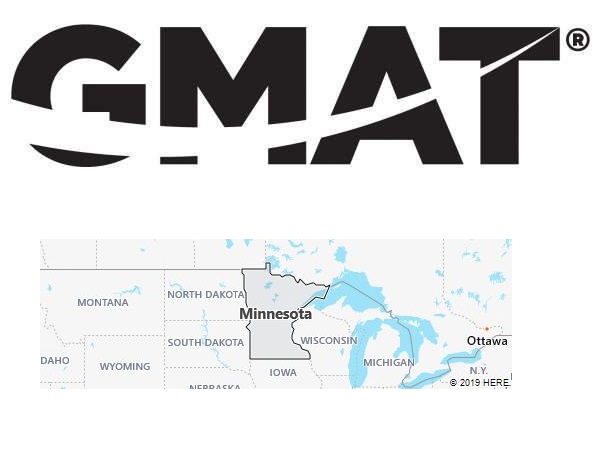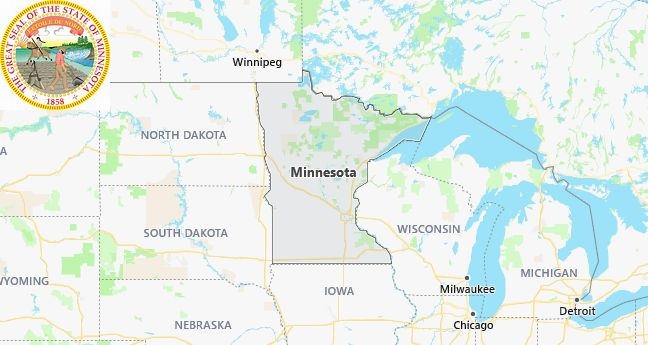Minnesota is a state in the Midwest of the United States, one of the so-called states of the Northwest Center. Ethnic composition: Germans – 37.3%, Norwegians – 17.0%, Irish – 12.2%, Swedes – 10.0%. The capital is Saint Paul. The largest city is Minneapolis. Other major cities: Bloomington, Duluth, Rochester, Brooklyn Park. The official motto of the state is the Star of the North.
STATE NAME
The name of the state of Minnesota comes from the name of the Minnesota River, given to it by the native inhabitants of North America – the Indians. In the language of the Dakota Indians, the word Mnisota (namely, as they called the Minnesota River) means “sky-colored water” or “muddy water.” There are many places in Minnesota whose names are related to the name of the state. Among them are a tributary of the Mississippi River, the Minnehaha Creek, Lake Minnetonka, the Minnehaha Falls, the largest city in the state of Minneapolis and others.
GEOGRAPHY
The state of Minnesota is located in the Midwest of the United States and belongs to the northwestern central states of the United States. The territory of the state of Minnesota is 225,181 km2 (12th place among US states). Minnesota borders Canada in the north, Michigan in the northeast (water border along Lake Superior), Wisconsin in the east, Iowa in the south, South Dakota and North Dakota in the West.
Minnesota is the northernmost state in the continental United States, only Alaska is further north. Northeast Minnesota is part of the Laurentian Uplands, the oldest (more than 2.7 billion years) geological formation. This region is characterized by a thin layer of soil, numerous rock outcrops, thousands of lakes and streams. It is here that the highest point of the state is located – Eagle Mountain (701 meters above sea level), reserves Voyagers National Park, Lake Superior National Forest, Chippewa National Forest and others.
Almost the entire north of Minnesota is covered with what is known as Laurentian mixed forests. Pine, spruce, fir, juniper, aspen, oak, birch, mountain ash, maple grow here. Black bears, elks, white-tailed deer, lynxes and many other animals live in the forests. Minnesota has the largest wolf population in the United States outside of Alaska. The northwest of the state is a vast plain that was once the bottom of a lake formed by a melting glacier (in general, during the last glaciation, glaciers covered almost the entire surface of modern Minnesota, with the exception of only the southeast state). The west and southwest of Minnesota are prairies covered with grasses and steppe shrubs. Deciduous forests are located in the southeast of the state.
HYDROGRAPHY
Minnesota is called the “state of ten thousand lakes”, according to official statistics in the state there are almost twelve thousand lakes, the area of \u200b\u200bwhich exceeds ten acres (40,000 m2). The largest and deepest of them is, of course, Lake Superior, one of the Great Lakes of North America.
The state has about six and a half thousand rivers and streams, it is in Minnesota that the sources of the largest river in the United States, the Mississippi, are located.
CLIMATE
Minnesota has a continental climate with cold, snowy winters and hot summers. The climate of the areas located near Lake Superior is significantly influenced by this huge body of water, somewhat softening the weather conditions.
In Minnesota’s largest city, Minneapolis, temperatures in the coldest month, January, typically range from -15°C to -6°C. In the hottest summer month, July, temperatures range from 17°C to 28°C.
The city of International Falls, located in the north of the state, is considered the coldest in the continental United States, it is even called the “freezer of the nation.” The average January temperature here is from -10°C to -22°C, and the record low is -48°C. In summer, in July, the temperature in the city ranges from 12°C to 26°C.
The southern part of Minnesota is located in the area of the so-called “tornado alley”, here quite often (more than twenty times a year) hurricane whirlwinds pass, usually in the summer months.
ECONOMY
The economy of Minnesota, like the United States as a whole, is characterized by diversity, there are no clearly leading directions, but there are many well-developed industries.
Minnesota is home to the headquarters of several major financial institutions, including UnitedHealth Group, the largest health insurance company in the United States, US Bancorp, TCF Bank, and others.
Biotechnology companies and medicine are very well developed in the state. Rochester is home to the headquarters of the Mayo Clinic, one of the leading medical institutions in the United States; Medtronic, the largest manufacturer of medical equipment, operates in Minneapolis; St. Jude Medical manufactures pacemakers, prosthetic heart valves, and more.
Mining has traditionally been important to Minnesota, primarily iron ore. Although rich deposits are almost exhausted today, enrichment of poorer ores is nevertheless beneficial. In addition, sand, crushed stone and other building materials are mined in the state.
TOURISM
In recent decades, tourism has become an increasingly important sector of the economy; excellent fishing, hunting, water and winter sports attract millions of people to the state every year.
Also interesting for tourists (and, of course, for local residents) is the annual St. Paul’s Winter Carnival, which has been held in St. Paul since the end of the 19th century, theaters and museums in Minnesota, and numerous state reserves.
Augsburg College Rankings

Overview of Augsburg College Augsburg University, located in Minneapolis, Minnesota, is a private liberal arts institution affiliated with the Evangelical Lutheran Church in America (ELCA). As of my last knowledge update in January 2022, please note that there may have…
Read more





























